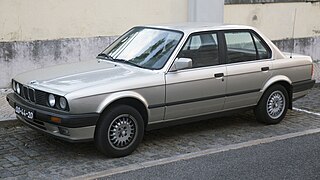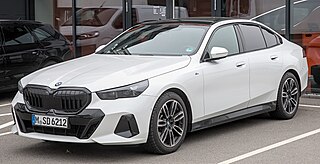
The BMW 5 Series is an executive car manufactured and marketed by BMW since 1972, succeeding the New Class Sedans, and currently in its eight generation.

The BMW M20 is a SOHC straight-six petrol engine which was produced from 1977 to 1993. It was introduced eight years after the larger BMW M30 straight-six engine, which remained in production alongside the M20.

The BMW M50 is a straight-6 DOHC petrol engine which was produced from 1990 to 1996. It was released in the E34 520i and 525i, to replace the M20 engine.

BMW M62 is a naturally aspirated V8 petrol engine which was produced from 1995 to 2005. A successor to the BMW M60, the M62 features an aluminium engine block and a single row timing chain.

The BMW E12 is the first generation of 5 Series executive cars, which was produced from 1972 to 1981 and replaced the saloon models of the BMW New Class range.

The BMW E28 is the second generation of BMW 5 Series executive cars, which was produced from 1981 to 1988 and replaced the E12 5 Series. Pre-series production began in April 1981 and the car was introduced in the autumn that year.

The BMW E30 is the second generation of BMW 3 Series, which was produced from 1982 to 1994 and replaced the E21 3 Series. The model range included 2-door coupe and convertible body styles, as well as being the first 3 Series to be produced in 4-door sedan and wagon/estate body styles. It was powered by four-cylinder petrol, six-cylinder petrol and six-cylinder diesel engines, the latter a first for the 3 Series. The E30 325iX model was the first BMW to have all-wheel drive.

The third generation of the BMW 3 Series range of compact executive cars is designated under the model code E36, and was produced by the German automaker BMW from 1990 to 2000. The initial models were of the four-door sedan body style, followed by the coupé, convertible, wagon ("Touring"), and eventually hatchback ("Compact").

The fourth generation of the BMW 3 Series range of compact executive cars is designated under the model code E46, which was produced by the German automaker BMW from 1997 to 2006, and was the successor to the E36 3 Series which ceased production in 2000. First introduced in November 1997, the E46 was available in sedan, coupé, convertible, station wagon and hatchback body styles. The latter has been marketed as the 3 Series Compact.

The BMW E39 is the fourth generation of the BMW 5 Series range of executive cars, which was manufactured from 1995 to 2004. It was launched in the sedan body style, with the station wagon body style introduced in 1996. The E39 was replaced by the E60 5 Series in 2003, however E39 Touring models remained in production until May 2004.

The fifth generation of the BMW 5 Series executive cars consists of the BMW E60 and BMW E61. The E60/E61 generation was produced by BMW from 2003 to 2010 and is often collectively referred to as the E60.

BMW M GmbH, formerly known as BMW Motorsport GmbH, is a subsidiary of BMW AG that manufactures performance cars.

The BMW M5 is a high-performance variant of the BMW 5 Series marketed under the BMW M sub-brand. It is considered an iconic vehicle in the sports sedan category. The M5 has always been produced in the sedan (saloon) body style, but in some countries the M5 has also been available as a wagon (estate) from 1992 to 1995, from 2006 to 2010, and since 2024.

Alpina Burkard Bovensiepen GmbH & Co. KG is an automobile manufacturing company based in Buchloe, in the Ostallgäu district of Bavaria, Germany that develops and sells high-performance versions of BMW cars. Alpina works closely with BMW and their processes are integrated into BMW's production lines, and is recognized by the German Ministry of Transport as an automobile manufacturer, in contrast to other performance specialists, which are aftermarket tuners. The Alpina B7 is produced at the same assembly line in Dingolfing, Germany, as BMW's own 7 Series. The B7's twin-turbo 4.4-litre V8 is assembled by hand at Alpina's facility in Buchloe, Germany, before being shipped to BMW for installation, and the assembled vehicle is then sent back to Alpina for finishing touches.
The 4HP is a four-speed Automatic transmission family with a hydrodynamic Torque converter with an electronic hydraulic control for passenger cars from ZF Friedrichshafen AG. In selector level position "P", the output is locked mechanically. The Simpson planetary gearset types were first introduced in 1980, the Ravigneaux planetary gearset types in 1984 and produced through 2003 in different versions and were used in a large number of vehicles.
The 420G is a 6-speed manual transmission manufactured by Getrag. It is designed for longitudinal engine applications and for use on engines producing up to 499 N⋅m (368 lb⋅ft) of torque.

The sixth generation of the BMW 5 Series consists of the BMW F10, F18, BMW F11 and BMW F07 executive cars and were produced by BMW from January 2010 to 2017, with F10 being launched on 20 March 2010 to domestic market and F11 in the summer of 2010. The F07 Gran Turismo was produced from early September 2009 to 2017, being launched in the domestic German market in late October 2009.
5HP is ZF Friedrichshafen AG's trademark name for its five-speed automatic transmission models for longitudinal engine applications, designed and built by ZF's subsidiary in Saarbrücken.

The BMW 5 Series (G60) is an executive car manufactured and marketed by German luxury automaker BMW since 2023. The lineup consists of the G60 saloon, G61 estate, and the G68 long-wheelbase sedan. It represents the eighth generation of the BMW 5 Series, succeeding the G30 model and the G32 6 Series liftback.




























